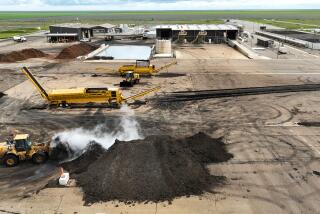Stubborn plastic may have finally met its match: the hungry wax worm

A wax worm can chew a hole through plastic and winds up covered with polyethylene debris. (Sign up for our free video newsletter here http://bit.ly/2n6VKPR)
- Share via
Here’s a caterpillar that thinks plastic tastes fantastic. Scientists have discovered that the larvae of the wax moth will easily munch through a common plastic known as polyethylene, turning it into a useful compound found in all kinds of consumer products.
The findings, published this week in the journal Current Biology, reveal an unlikely ally in the fight to reduce and reuse the enormous amounts of plastic waste that humans produce every year.
Plastic, made from oil, is the product of fossil fuels. Roughly 92% of it falls into two main categories: polyethylene and polypropylene. According to the study authors, polyethylene is widely used for packaging and so makes up about two-fifths of the plastic product demand.
Some of that plastic is recycled, but not much — out of 33.25 million tons of plastic generated in 2014, just 9.5% in the United States was recycled, according to the Environmental Protection Agency. An additional 15% was burned for energy, which is not the cleanest process, and the remaining 75.5% ended up in landfills.
“New solutions for plastic degradation are urgently needed,” the study authors wrote.
The problem is that such plastics are difficult to break down, said study coauthor Christopher J. Howe, a biochemist at Cambridge University in England. Polyethylene molecules have straight backbones of linked carbon atoms whose bonds are very stable. This means plastic doesn’t biodegrade easily in landfills, and it can form garbage patches in the ocean that pose deadly threats to marine wildlife.
Scientists have come across a few modest instances of polyethylene biodegradation, but they’re slow going. Researchers got a liquid culture of Penicillium simplicissimum fungus to break down some polyethylene — but it took three months. A bacterium, Nocardia asteroides, took four to seven months. Both appeared to produce ethylene glycol, a compound used in all kinds of products, including brake fluid, paints, plastics and even cosmetics.
This new study of the wax moth Galleria mellonella, an insect that inhabits bee hives and other places, changes that.
The discovery was something of a happy accident, Howe said: Lead author Federica Bertocchini, a developmental biologist at Institute of Biomedicine and Biotechnology of Cantabria in Spain, is a beekeper as well as a scientist. It was Bertocchini who noticed that if hive material containing moth larvae was wrapped in plastic bags, the caterpillars appeared to degrade tough plastic.
Could these little caterpillars really do something that few critters are known to do?
To find out, the researchers set wax worms loose on a polyethylene film. They watched as holes appeared after just 40 minutes — at an estimated rate of about 2.2 holes per worm per hour. And when the researchers put roughly 100 wax moth larvae on a commercial shopping bag, they ate a total of 92 milligrams in about 12 hours.
Still, it was possible these wax worms were simply munching up material rather than actually digesting it into simpler products. So the scientists made a slurry of some worms and smeared the dissociated cells on polyethylene films. After 14 hours, the researchers found that 13% of the polyethylene mass had been lost — a degradation rate of 0.23 of a milligram per square centimeter.
When the researchers examined what remained of the slurry-coated plastic film, they found a signature that indicated the presence of that oh-so-useful compound, ethylene glycol — a sign that the caterpillar cells really had broken the plastic down.
How does the wax worm manage such a difficult feat, and do it with such incredible speed? It’s all thanks to the natural diet of this caterpillar, which makes its home within the honeycomb.
It’s “probably because the beeswax in the hives is similar chemically to the plastic,” Howe said. “The larvae have evolved to be able to break down the beeswax, and can break down plastic as well, given the chemical similarity.”
Beeswax is made of a wide variety of compounds, including alkanes, alkenes, fatty acids and esters. Many of those compounds include those carbon-carbon bonds — which could mean the wax moth has a natural talent for breaking those down.
So far, the scientists are not sure whether this ability is due to the wax moth larva, or to the microbes within its gut. An earlier study by a different group found that two bacterial strains taken from the gut of the Indian mealmoth could break down plastic in a few weeks (though the authors did not report seeing any ethylene glycol production).
Finding out which critter is responsible is one of the next steps in the research, Howe said.
“In the long term we’d like to use this as a basis for breaking down waste polyethylene — but there are many hurdles to be overcome in scaling the process up,” he said. “We would probably try to find the gene(s) for the enzyme(s) that are responsible, and use the gene to make lots of the enzyme in a biotechnological process rather than growing large numbers of the caterpillars.”
Follow @aminawrite on Twitter for more science news and “like” Los Angeles Times Science & Health on Facebook.
MORE IN SCIENCE
‘We need to be out here’: Thousands march in downtown L.A. to support science in the Trump era
Scientists get a rare view of a type Ia supernova magnified 50 times
Why the next flu medicine could come from frog mucus







